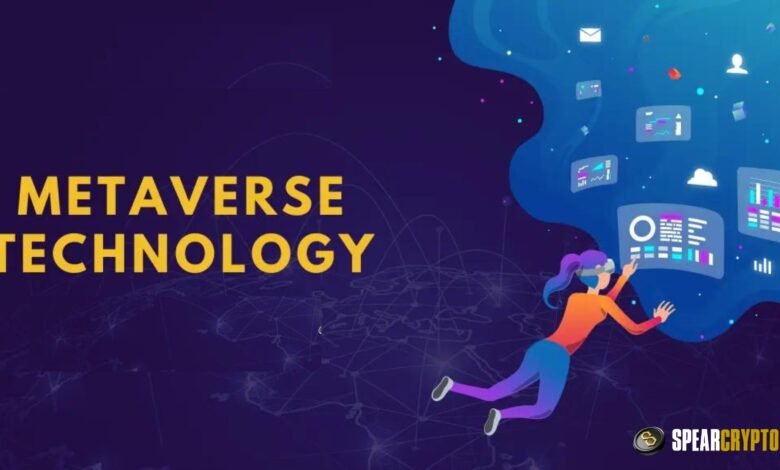
Metaverse Technology. One of the most noticeable advantages we’ve gained from technology is connectivity. Smartphones, tablets, laptops, and desktop computers linked to the internet have brought individuals from all corners of the globe closer together. A long time ago, the only thing you could do on the internet was peruse web pages.
You may now make material and distribute it across various online forums and social media sites. With the help of Metaverse technology, we are about to enter the next generation of the internet, where the whole thing will function as a giant open virtual playground. A common conception of the metaverse has been that it is a virtual version of the real world or at least a reflection of it.
Investigating the metaverse’s foundations thoroughly will solve all these issues. An introduction to the metaverse and the technologies that could propel its growth is given in the following discussion. The metaverse is a great place to study the fundamental characteristics of many technologies and think critically about some prime examples.
What is Metaverse Technology?
Anyone thinking about metaverse technology would naturally want to know what it means. The various competing explanations of the metaverse are sure to throw you for a loop. The opposite is true; you must agree on how the metaverse is generally understood. People can explore and engage with each other in the persistent, open, shared, and massive metaverse using their digital avatars. A great deal of nuanced interaction is also possible in the metaverse.
The science fiction writer Neal Stephenson used the phrase “metaverse” in his 1992 book Snow Crash, where the concept first emerged. Analysing Stephenson’s novel’s description of a metaverse reveals numerous parallels to the suggested metaverse concept.
Uses of Metaverse
The second most significant thing people think about when talking about the metaverse is the practical applications of metaverse technology. If you want to learn more about the metaverse, you should try to figure out how it might be useful in the real world.
At this time, open-world games and other forms of virtual immersion are the primary uses of metaverse technologies. However, the metaverse can do much more than that, and the variety of use cases may define the future development it supports. According to industry insiders, the following are a few of the most exciting potential uses of the metaverse that will fuel its expansion.
- Non-competitive social interactions in virtual environments other than mission-oriented games.
- All the features and activities in these 3D virtual worlds are just as in the real world.
- A virtual economy allows users to create virtual stocks, NFTs, items, and more while maintaining ties to the actual world.
- New hardware for metaverse applications drives complex models, including enhanced virtual and augmented reality technologies.
- Continued assistance for user-generated content, including virtual objects, experiences, and settings.
The various possible uses of metaverse call for using the best metaverse technology to achieve faster growth in this domain. However, knowing how you can fit the different technologies together in a coordinated framework is important. This is where you need a clear overview of the architecture of the metaverse.
Components in the Metaverse
Studying the interplay between a metaverse’s components can give you a good idea of the most well-known metaverse technology. When contemplating the metaverse, one must go beyond the notion of a massive virtual universe. Contrarily, you must examine the various parts of the metaverse technology. The various parts of the metaverse are described here.
Infrastructure
No technological solution or platform can function without the right foundation. Technology for connection, including the cloud, Wi-Fi, and computer resources, would provide the backbone of the metaverse’s infrastructure.
Interface
The user interface is the next critical component in making metaverse technology more accessible. A wide variety of interface technologies, including virtual reality headsets, haptics, augmented reality glasses, and more, allow users to access the metaverse.
Decentralization
When designing a public and shared metaverse, decentralization is a crucial component. You can freely access and navigate the metaverse using a variety of examples of metaverse technology. The decentralization necessary for the metaverse to function is that it does not have a single controlling entity. Technologies like blockchain, edge computing, AI, and others developed for democratization are part of the metaverse that allows decentralization.
Spatial Computing
It can be challenging to interact with virtual environments that are three dimensions without the use of spatial computing. Therefore, spatial computing technologies like 3D modeling and visualization tools are absolutely necessary. These tools are essential for creating the metaverse’s main attractions: immersive experiences.
Creator Economy
One additional notable aspect of metaverse technology is its potential for facilitating the establishment of autonomous economies. A creator economy is essential to any metaverse platform to facilitate the unfettered and free flow of capital throughout the metaverse ecosystem. A suite of design resources, online marketplaces, and digital assets would be the backbone of a creator economy.
Discovery
Metaverse technology is essentially a new and open 3D internet, as you must have discovered. Tools that may lead people to specific locations are also necessary for the metaverse. Thus, you’d see that the metaverse components need the ‘Discovery’ part. On the metaverse’s “Discovery” side, the content engine that drives engagement is front and center. Simultaneously, it includes traditional web user experience components such as social networking, reviews, ads, and ratings.
Experiences
One last thing about the metaverse is how it highlights the enormous possibilities of metaverse technology. One of the major components of the metaverse is experiences, which power virtual reality (VR) versions of various digital applications. Through metaverse-enabled experiences, you can engage in 3D social media interactions and work in immersive workplaces.
Technologies Behind the Metaverse
The metaverse has generated unprecedented interest but is still far from becoming a reality. On the other hand, finding the top metaverse technology can shed light on its future. Examining the leading technologies that have contributed to the creation of the metaverse can provide the answers to these issues.
Blockchain
Without question, the two most important metaverse technologies for molding the virtual version of our physical reality are blockchain and cryptocurrency. With blockchain technology, you can acquire a transparent and decentralized solution for digitally proving ownership. However, cryptocurrency has the potential to facilitate the movement of value among users’ various metaverse activities and interactions. In the Decentraland metaverse, for instance, users can use the native currency to buy virtual plots of land. Above all else, cryptocurrency can incentivize people to contribute to the metaverse.
Augmented Reality and Virtual Reality
The two most well-known technologies for providing exciting and realistic 3D experiences in the metaverse are augmented reality and virtual reality. Above all else, they are the standards all examples of metaverse technology must meet to enter the virtual realms. However, many remain perplexed about what augmented and virtual reality mean for the metaverse.
Through the use of digital visual components and characters, augmented reality can alter the physical environment. Augmented reality is readily available on any digital device with a camera, including smartphones. With augmented reality apps, users may see their environment with dynamic graphics. Virtual reality (VR) is an entirely new gaming genre, though. Virtual reality (VR) goggles, sensors, and gloves allow users to enter these computer-generated worlds. Augmented and virtual reality in metaverse technology use cases will grow in popularity as these technologies progress.
Artificial Intelligence
In the category of metaverse technology, artificial intelligence (AI) would be the next item. Artificial intelligence has discovered numerous potential uses in our daily lives in recent years. AI has revolutionized numerous fields, including strategic planning, efficient computing, face recognition, and insights-based decision-making. Recently, there has been a lot of talk about how to use AI to make metaverse platforms that people really want to use.
For instance, AI can be a one-of-a-kind technique for enabling non-player characters in the metaverse to respond. Also, AI is the greatest metaverse technology for making avatars in the metaverse. By analyzing photos or 3D scans, AI systems may create lifelike avatars with various facial expressions, clothing options, and personality quirks.
Internet of Things
Because it connects the physical and digital realms, the Internet of Things (IoT) is another ubiquitous technology in the metaverse. The Internet of Things (IoT) links many gadgets to a mountain of data, including thermostats, cameras, medical equipment, and voice-activated speakers. Data collection and provisioning from the physical world would provide the backbone of IoT applications in the metaverse. Thus, the Internet of Things (IoT) can lead to more precise digital depictions in the metaverse. The integration with physical objects also improves the chances of using the Internet of Things for metaverse simulations in real-time.
3D Reconstruction
The real estate market has seen a surge in the use of 3D reconstruction, even though it is not new among metaverse technology. Many firms began to offer virtual property tours using 3D reconstruction as the trend of virtual real estate tours gained momentum. Potential buyers can virtually tour the new homes from anywhere globally before deciding. If we want to build a metaverse that seems as natural and realistic as the actual world, 3D reconstruction will be crucial.
Examples of Metaverse Technology
An engaging introduction to metaverse technology would provide a synopsis of their practical applications. These are some of the more prominent instances that point to promising future developments in the metaverse.
Decentraland
One such open metaverse platform is Decentraland, where users can purchase virtual plots of land. Founded in 2017, the Decentraland metaverse has seen an increase in virtual real estate auctions.
Sandbox
Sandbox is another well-known example of metaverse technology; it was an early developer of metaverse games. In the Sandbox platform, players can find virtual plots of land and the resources they need to build their in-game items and adventures.
Second Life
By studying Second Life and similar instances, you can also get a good feel for the possibilities of metaverse technologies. It exemplifies the potential long-term evolution of the metaverse by including numerous additional communities. The freedom to design one’s unique avatar is the most eye-catching feature of Second Life.
Conclusion
Thanks to the various real-world uses of metaverse technologies, there is hope for the metaverse’s future. However, the possibilities for the metaverse will increase as each part develops further. For instance, creating augmented and virtual reality experiences in the metaverse would not guarantee its survival.
Metaverse development, on the other hand, emphasizes decentralization, experiences, the creative economy, and networking technology. The race to construct a functional metaverse is ongoing as more and more major corporations join the field daily.







